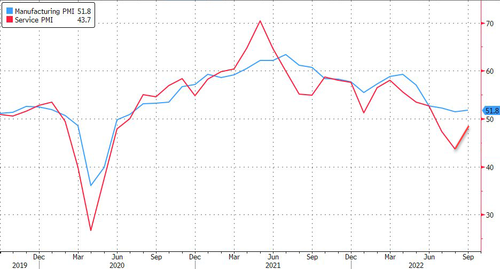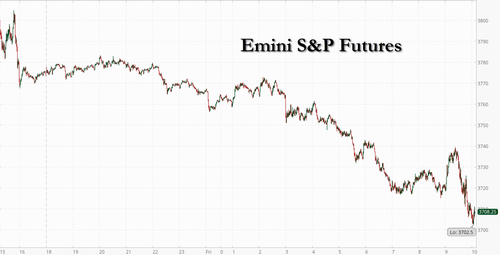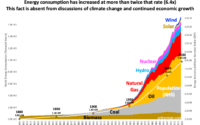Stocks Spooked To Session Lows By Unexpectedly Strong PMIs
After last month’s shocking PMI print which saw the Service component crater to post Covid crash low of 43.7, and paradoxically spark the last burst higher of the bear market rally as it suggested a recession is now inevitable, moments ago we got more bad news from S&P Global (which took over the compilation of US PMI data from Markit), when it reported that both the manufacturing and service PMIs rebounded from last month’s post-covid lows, and in fact both beat expectations, to wit:
- Manufacturing PMI 51.8, Exp. 51.0, Last 51.5
- Service PMI 49.2, Exp. 45.5, Last 43.7

The Composite PMI rose to 49.3 in September, up from 44.6 in August, solidly beating expectations of 465.1, and signaled a softer and only marginal decline in private sector business activity. The decrease was also the slowest in the current three-month sequence of contraction.
As S&P Global notes, “contractions in activity across the manufacturing and service sectors eased”, and the “overall decrease was only marginal and signalled a notably slower rate of decline compared to that seen in August.” Although manufacturers continued to register a slight fall in production, service providers signalled a much slower pace of decline in output.
But the worst news, in this world where good news is bad news, is that private sector employment rose further in September, with the moderate upturn in workforce numbers reflecting expansions in manufacturing and service sector staffing levels: “The rate of job creation at goods producers was the sharpest for six months amid greater success in hiring suitable candidates for vacancies.”
Some more details:
- New orders received by private sector firms returned to expansionary territory in September, with growth broad-based across the manufacturing and service sectors. The upturn was only mild, despite being the quickest since May. Where an increase was noted, some firms linked this to the acquisition of new clients.
- The rate of expansion was historically subdued, however, as a number of companies suggested that inflationary pressures continued to weigh on customer spending.
- New export orders remained in contraction, with the rate of decrease the second-fastest since May 2020.
- For the fourth month running, the rate of input cost inflation eased during September. The pace of increase was the slowest since the start of 2021, as manufacturers and service providers recorded slower upticks in operating expenses.
- That said, cost burdens continued to rise at an historically elevated pace, with interest rate hikes and S&P Global Flash US PMI Composite Output Index material and wage increases driving inflation.
- Reflecting softer rises in cost burdens, firms increased their selling prices at a slower pace at the end of the third quarter. That said, the moderation was led by service providers as manufacturers registered a sharper uptick in output charges in an effort to pass on higher costs to clients.
- In line with a renewed rise in new orders, private sector firms signalled growth in backlogs of work during September. The increase was only marginal overall, but contrasted with a solid decline in August.
- Manufacturers continued to note difficulties in working through orders due to transportation and supply chain disruption, with capacity constraints hampering service providers for the first time since May.
- Employment across the private sector rose further in September, albeit at a softer pace than in August. The moderate upturn in workforce numbers reflected expansions in manufacturing and service sector staffing levels. The rate of job creation at goods producers was the sharpest for six months amid greater success in hiring suitable candidates for vacancies
Commenting on the flash PMI data, Chris Williamson, Chief Business Economist at S&P Global Market Intelligence said:
“US businesses are reporting a third consecutive monthly fall in output during September, rounding off the weakest quarter for the economy since the global financial crisis if the pandemic lockdowns of early-2020 are excluded. However, while output declined in both manufacturing and services during September, in both cases the rate of contraction moderated compared to August, notably in services, with orders books returning to modest growth, allaying some concerns about the depth of the current
downturn.“There was also better news on inflation, with supplier shortages easing to the lowest since October 2020, helping take some of the pressure off raw material prices. These improved supply chains, accompanied by the marked softening of demand since earlier in the year, helped cool overall the rate of inflation of both firms’ costs and average selling prices for goods and services to the lowest since early-2021.
What Williamson may not know when he says “better” is that the market interprets any marginal improvement as the worst possible outcome, since it means the recession is not as strong as expected and the all important massive job losses – which are a critical condition for the Fed to stop hiking – are still not here. It’s also why futures tumbled to fresh session lows after the report.

[ad_2]
Source link

